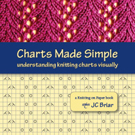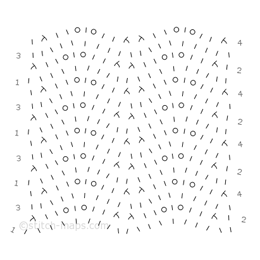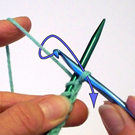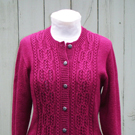Knitting is an endless source of fascination for me. It’s just loops of yarn, but what you can do with those loops! Sweaters, socks, hats, mittens, and scarves. Bold cables, ethereal lace, and fluffy brioche.
Teaching is an excuse to delve deeply, to study the myriad ways of knitting a mitten thumb, turning a heel, or simply casting on. But the best part of teaching is catching the “ah ha!” lightbulb moment as a student suddenly grasps a new concept.
To make my students successful, I aim to:
- accomodate each knitter’s knitting style, learning style, and skill level
- adapt the class material to meet the particular interests of each group
- provide comprehensive, illustrated handouts for use in class and at home
- leave plenty of time for hands-on practice
Does one of the classes below intrigue you? See if it’s currently listed on my schedule. Or contact me to schedule workshops for your yarn shop, guild, or fiber festival.
| Duration | |
| Required skills | |
| Topic |
All Thumbs
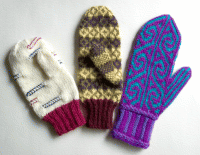
Mittens are great portable projects. Since they don’t require much yarn, they’re also great stash-busters. The only tricky part is the thumbs. Learn a handful of thumb options in this class, from the simple to the anatomically correct.
Bind-off Bonanza
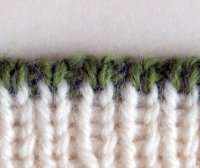
Creating a firm and sturdy bind-off edge is child’s play: you just keep a secure grip on the yarn as you bind off. But what if you need some other kind of bind-off edge? Take this class and learn about supple and seamless bind-offs for sock tops, bind-offs that blend into ribbing, and decorative bind-offs.
Bind-off Bonanza is an in-depth, three-hour class. Compare it to the 90-minute Stretchy Bind-offs.
Brioche Wristers

Brioche rib worked in two colors is amazing. Even though you work one-row stripes, you get vertical ribs of color in a squishy, cozy, reversible fabric. And when worked in the round, it’s a simple two-round pattern. Learn all the basics in this class by starting a pair of wristers: working brioche slip stitches both on knit rounds and on purl rounds; casting on and binding off effectively; keeping your yarns from tangling; and fixing mistakes.
Cast-on Cornucopia
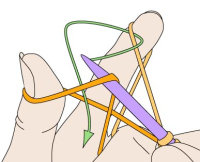
Dozens of cast-on techniques exist: one-strand or two-strand; loose and flowing or elastic and springy; invisible or decorative. Review your options in this class—try variations on old favorites, and discover entirely new options. Best of all, gain the familiarity you need to choose just the right cast-on for your next project.
Cast-on Cornucopia is an in-depth, three- or six-hour class. Compare it to the 90-minute Cast-on Trickery and Not Your Grandma’s Long-tail Cast-on.
Cast-on Trickery
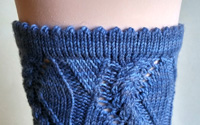
It’s a shame that many knitters aren’t familiar with provisional cast-ons. They permit all sorts of trickery: no-sew hems, scarves with identical ends, seamless underarms in top-down sweaters, and much more. Try a few provisional cast-ons, and find your new favorite.
Cast-on Trickery is a quick, 90-minute class. Compare it to the three- or six-hour Cast-on Cornucopia.
Charts Made Essential
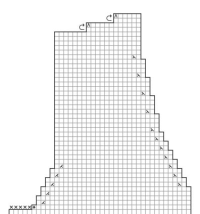
Now that you’re confident in your ability to read charts, take this class and learn to write charts: to visualize written instructions, to convert between flat and in-the-round knitting, and to plan shaping. Use charts to demystify phrases like “at the same time,” “reverse shaping,” and “shape in pattern.”
Charts Made Simple
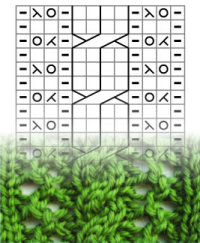
The symbols of a chart take the place of written instructions, telling you what stitches to work. But a good chart does so much more, showing you what the knitted fabric should look like. In this class, you’ll learn to read charts, making sense of their symbols and using them to keep your knitting on track and to minimize mistakes.
Disaster Recovery
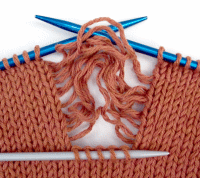
Mistakes happen. Fortunately, knitters have an array of techniques for dealing with mistakes. Learn when and how to tink, drop, and frog. See how duplicate stitch can cover over goofs in colorwork. And pick up tips for avoiding mistakes in the first place.
Disaster Recovery is an in-depth, three-hour class. Compare it to the 90-minute Tink Drop Frog.
Entrelac Basics
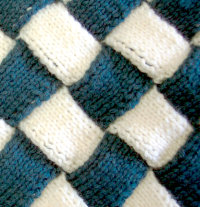
Entrelac fabric looks like strips of knitting woven over and under each other, but it’s really formed of individually-knit diamonds. No sewing is required: you join the diamonds together as you knit them. In this class, you’ll learn to form the basic units of entrelac: base triangles, side triangles, left- and right-leaning diamonds, and top triangles. You’ll also pick up tricks like knitting back backwards, and methods for sizing and shaping entrelac fabric.
Exploring with Stitch Maps
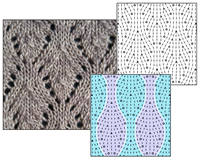
Traditional lace charts can be tricky to decipher, especially if they contain “no stitch” symbols. But stitch maps are different. These special grid-free charts reveal the secrets of lace patterns, exposing landmarks and other aids to successful lace knitting. Discover how to take advantage of stitch maps: how to learn from and knit from them, and how to create them. Practice in class by starting a simple lace scarf.
Get Twisted!
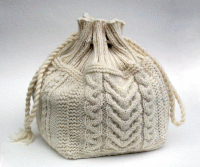
Cables and other twisted knitting stitches make for some of the most captivating knitting patterns. Though they look intricate, they are surprisingly easy to create. Learn how while knitting samplers that you can later turn into a drawstring tote bag. Along the way, you’ll pick up tips for reading charts, reading your knitting, and fixing mistakes.
Hook Hocus-Pocus
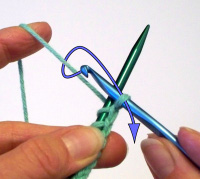
Maybe you’ve used a crochet hook to bind off, or to pick up a dropped stitch. But have you used one to join pieces together? To cast on provisionally? Or to stabilize an edge and provide a place from which to pick up stitches? Learn all of these techniques, plus embellishment, decorative edgings, and more.
Lace Basics
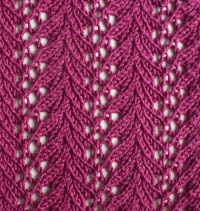
Yarn overs matched with decreases: that’s all lace is. But an incredible variety of lace patterns stems from the way a handful of decrease stitches are placed in relation to their matching yarn overs. Learn how to work these decreases, how to knit into a yarn over, and how to keep track of your lace knitting while working some sample swatches. Pick up tips for choosing appropriate yarn and needles, handling mistakes, and blocking.
Lace That Grows
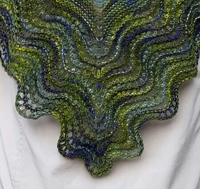
Imagine starting a lace shawl with just a few stitches, and “growing” in pattern until your shawl is big enough, with no worries about matching gauge or loosely casting on oodles of stitches. Picture choosing from a variety of shapes – triangles, squares, circles, semi-circles, and more – each composed of a series of lace “wedges,” sections that gradually grow wider as the knitting progresses. Take this class to learn how to grow a shawl of your own design. Pick from a selection of lace wedges, and see what shapes you can create by knitting your shawl from the top down or the center out. Learn how to estimate how much yarn you’ll need, or – if your yarn supply is limited – how large a shawl you can create from the yarn you have. By the end of class, you’ll be well on your way to a new, unique shawl.
This class was formerly known as Wedge Shawl Design.
Loving Your Lace Edgings
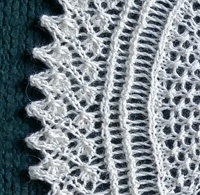
Adding a lace edging is a sweet way of topping off shawls, scarves, socks – or any other kind of project! In this class, you’ll learn where to find edging patterns, how you can use them, and how you can customize them. You’ll pick up tips for working tricky stitches – such as yarn overs at the beginning of a row – and for blocking. We’ll go over multiple options for attaching edgings, and you’ll have the chance to practice on a sample piece.
Manage Those Numbers!

What’s the best way to manage all the numbers in a pattern? With a spreadsheet! Learn spreadsheet basics for organizing gauges, measurements, and notes. Make friends with functions and formulas for determining stitch counts, figuring sleeve increases, estimating yardage requirements, and more. Pick up tips for ensuring your patterns are as error-free as possible.
Mapping Lace Scarves
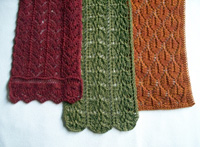
Traditional lace charts can be tricky to decipher, especially if they contain “no stitch” symbols. But stitch maps are different. These special grid-free charts unlock the secrets of lace patterns, exposing landmarks and other aids to successful lace knitting. Learn about stitch maps, and become skilled in using them to minimize mistakes while knitting. Practice in class by designing and starting a simple lace scarf.
Multi-directional Scarves
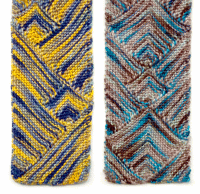
Turn variegated yarn into striking scarves with this new form of multi-directional knitting. Learn to form triangles and diamonds from a continuous length of yarn, and to join them together without sewing any seams or picking up any stitches.
Next Steps in Brioche
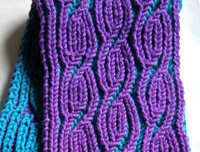
Maybe you’ve done one or two simple brioche projects, enough to know you like knitting brioche. What’s next? Take this class to expand your options: See what’s involved in knitting two-color brioche flat. (Hint: it’s a four-row pattern!) Add patterning via increases and decreases. Try a super-slick I-cord selvedge. You’ll practice by knitting a small sample in class, but take away the skills needed to complete a lovely patterned scarf.
This class was formerly known as Beginning Brioche. To ensure student success, it’s no longer recommended as an entry-level class. Instead, consider Brioche Wristers or Patterned Brioche.
Not Your Grandma's Long-tail Cast-on
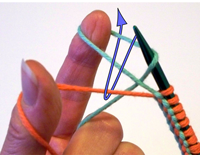
Did you know the long-tail cast-on comes in many flavors? Learn variations that create superior sproing (yes, that’s a technical term), a comfy rounded edge, and extra decorative appeal. Find out how to cast on so that you can work your first row as a right-side row, and still get the smooth side of the cast-on on the outside of your work. Discover ways of getting the long-tail cast-on to blend in with ribbing.
Not Your Grandma’s Long-tail Cast-on is a quick, 90-minute class. Compare it to the three- or six-hour Cast-on Cornucopia.
Patterned Brioche
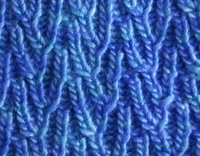
Take plain brioche rib, mix in some increases and decreases, and what do you get? Gorgeous patterning! Leaves and branches, feathers and faux cables: all created by increasing from one stitch to three (or five!) and decreasing from three (or five!) to one. Take this class to learn how to work these magic increases and decreases, to minimize bulk at the decrease points, and to choose the right decrease for the effect you want. Focus on working patterned brioche in a single color, avoiding the fuss of dealing with a second color. No prior brioche experience is necessary – you’ll pick up tips for forming the fabric, following instructions, fixing mistakes, and casting on and binding off effectively. And you’ll walk away with the start of a reversible scarf.
Selbuvotter

The patterning on traditional Selbu mittens is captivating; the shaping is ingenious. Delve into this art form by knitting a small sampler mitten. Learn to follow the thumb and hand charts, and find out how you can customize them. Practice increasing for the thumb gusset, creating the thumb opening, and picking up stitches for the thumb. And learn a little history along the way.
Slick Set-in Sleeves
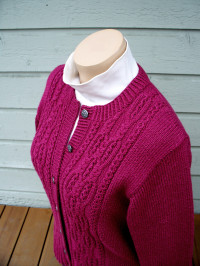
Set-in sleeves give a sweater a crisp, tailored look–and for easy knitting, you just can’t beat sleeves knit from the top down. Pick up stitches from the body, shape the sleeve cap with short rows, and you avoid the bulk of a seam and the fuss of easing a sleeve cap into an armhole. Learn to adapt an existing pattern to this approach, or to design according to your measurements.
Socktastic Stitch Patterns
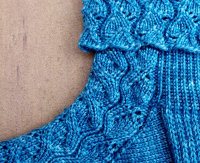
You can use nearly any stitch pattern for ordinary socks. But for fantastic socks, you need stitch patterns that have enough “give” for a snug but comfy fit, that allow for easy re-sizing, and that flow seamlessly into coordinated stitch patterns on the cuff, heel, and toe. Take this class to explore Socktastic patterns, to learn what makes a pattern shine in hand-painted yarn, and to see how to combine basic building blocks and tweak existing patterns to come up with your own Socktastic creations.
Stretchy Bind-offs
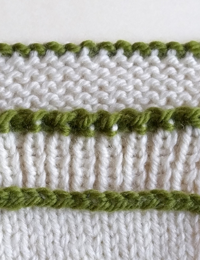
How do you keep your bind-off edge from being too tight? With a stretchy bind-off! Try options with bigger bind-off loops, with more elaborate loops, and simply with more loops. Learn about sewn bind-offs, sideways bind-offs, and bind-offs that use a crochet hook in novel ways.
Stretchy Bind-offs is a quick, 90-minute class. Compare it to the three-hour Bind-off Bonanza.
Syncopated Brioche
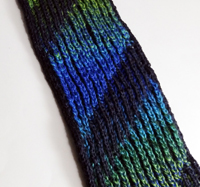
Making simple switcheroos in basic brioche rib leads to fascinating fabrics. Swap your knits and purls, and you’ll turn knit columns that protrude into purl columns that recede, and vice versa. Do this every few rows in one color, and you get a deep, waffle-textured fabric. Do this in two colors, and the effect is strikingly similar to shadow knitting. Explore your options in this class. Learn when and where to swap, to get the fabric you want.
Tink Drop Frog
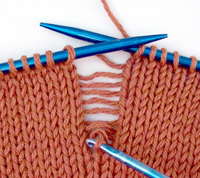
Experienced knitters know how to recover from mistakes. You, too, can be an experienced knitter. Learn the three essential recovery techniques: tink, drop, and frog. Practice on swatches and in simple situations to gain the confidence needed to tackle bigger disasters, and the ability to judge which technique to use when.
Tink Drop Frog is a quick, 90-minute class. Compare it to the three-hour Disaster Recovery.
Your First Stranded Colorwork
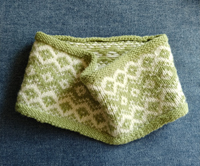
Have you always admired stranded colorwork, but been too intimidated to try it on your own? Ease into it with this class! Find out how to follow a colorwork chart and manage two yarns at once while creating smooth, unpuckered fabric. Learn about “color dominance,” and how to use it to your advantage. Discover the difference between stranded colorwork and Fair Isle. See how you can fix mistakes with duplicate stitch. And practice by knitting a simple, unshaped cowl in worsted-weight yarn.



